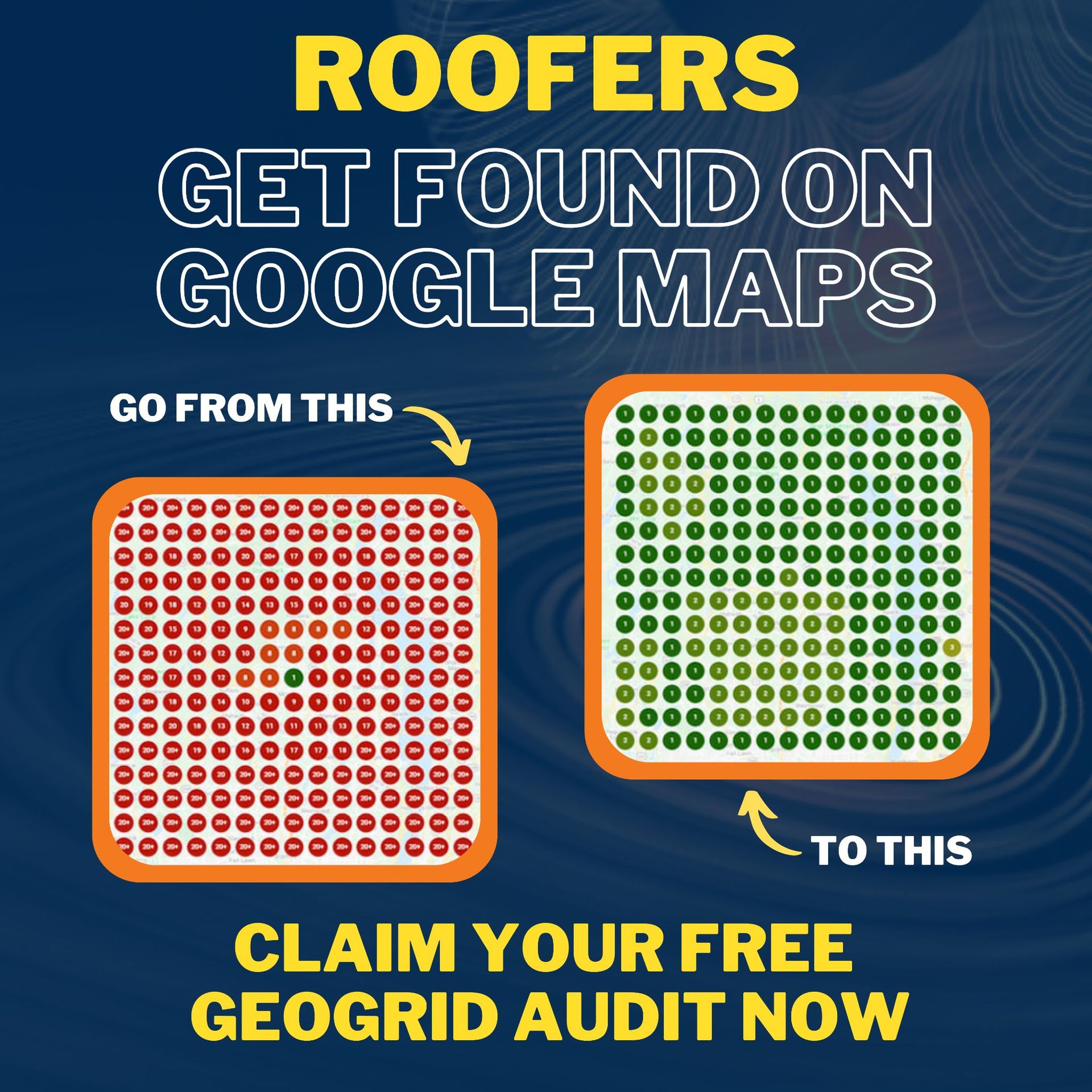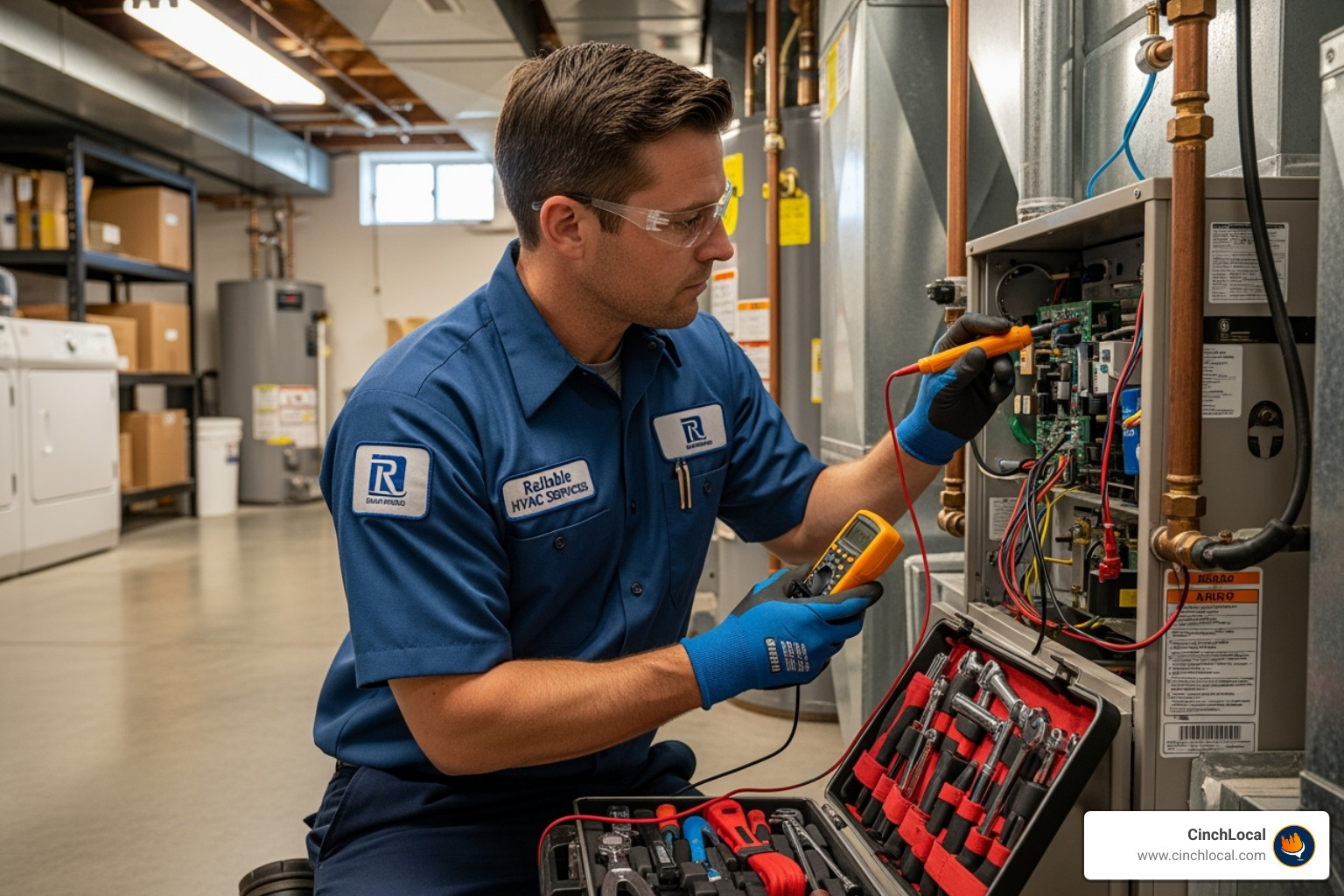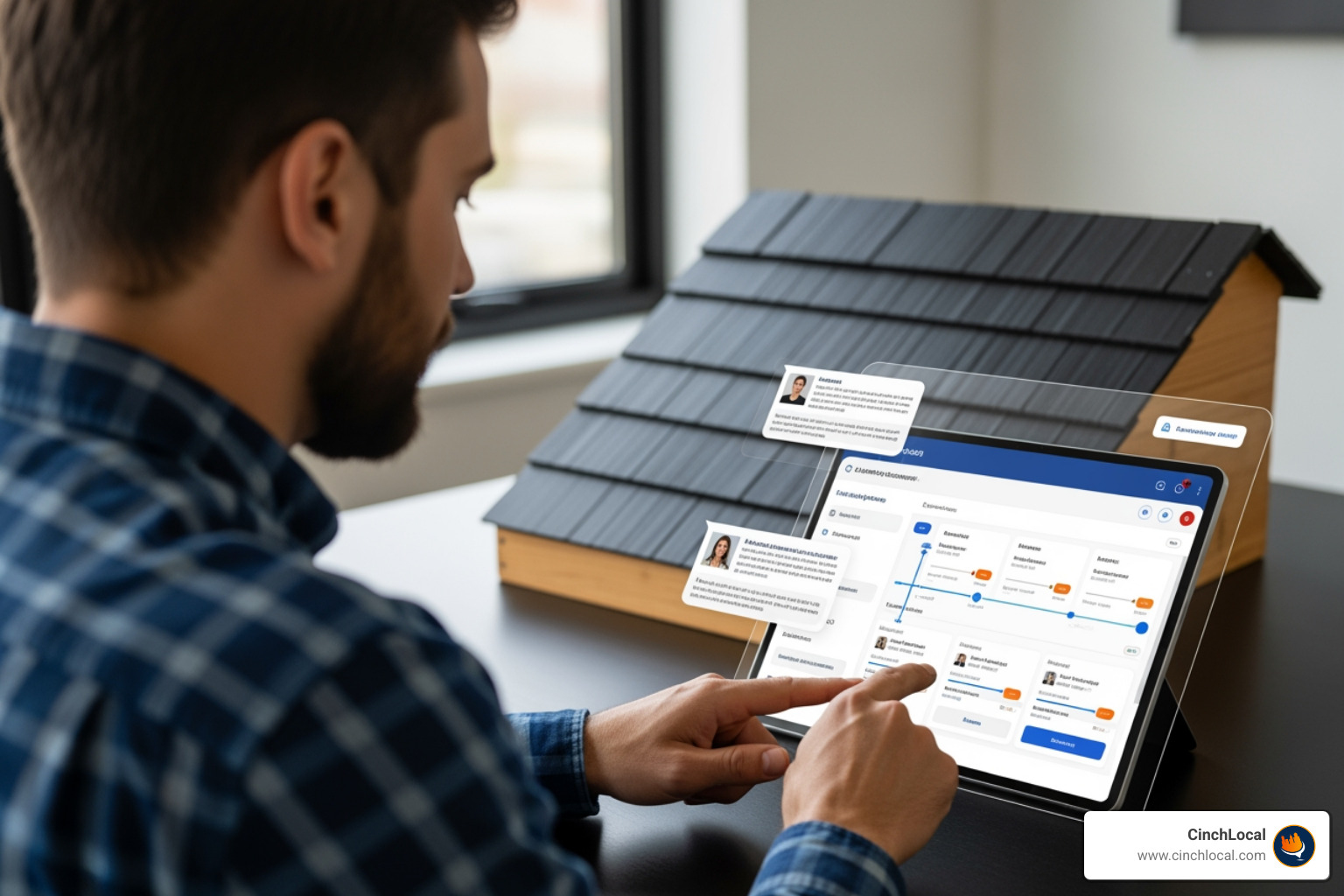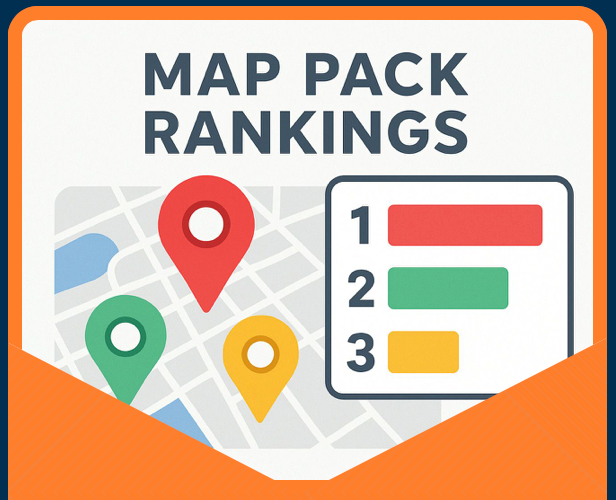
Cary Byrd // Founder of CinchLocal
Why Google Maps Visibility Is Crucial for Your Business

Google maps search engine optimization is the process of optimizing your business listing to rank higher in Google Maps results. This specialized form of local SEO helps businesses appear in the valuable "Map Pack" - the top three local businesses Google displays for relevant searches.
Here's a quick guide to Google Maps SEO success:
- Claim and verify your Google Business Profile
- Complete every field with accurate business information
- Maintain consistent NAP (Name, Address, Phone) across all online listings
- Select relevant categories that match your services
- Gather positive reviews and respond to all feedback
- Add high-quality photos of your business, team, and work
- Post regular updates through your Google Business Profile
When someone searches for "roofers near me" or "roof repair in [your city]," will they find your business? For 76% of people who search on smartphones for local businesses, the answer matters - they'll visit a store within 24 hours, and 28% of those visits end with a purchase.
The Google Map Pack accounts for nearly a third of all clicks on search results pages. That's potential business walking through your door - or your competitor's.
For roofing contractors, this visibility is especially critical. When homeowners need urgent repairs after storm damage or are planning a major renovation, they turn to Google Maps to find trusted local professionals. Without proper optimization, your business remains invisible to these high-intent searchers.
I'm Cary Byrd, founder of CinchLocal, and I've helped hundreds of roofing contractors transform their Google Maps presence through effective google maps search engine optimization strategies that drive quality leads and measurable results.

Key google maps search engine optimization vocabulary:
The Google Maps Algorithm Unpacked
Ever wonder how Google decides which roofing businesses show up in that coveted Map Pack? Understanding the "secret sauce" behind google maps search engine optimization starts with mastering three key ingredients that Google uses to rank local businesses.

According to Google's own documentation on how to improve your local ranking , your roofing company's visibility depends on this powerful trio:
- Relevance : How perfectly your business matches what homeowners are searching for
- Distance : How close you are to the person searching (or the area they specified)
- Prominence : How established and trustworthy Google thinks your business is
Let's break down each factor so you can start climbing those local rankings!
Why Relevance Matters
Think of relevance as speaking the same language as your potential customers. When someone types "emergency roof repair after storm damage" into their phone at 11 PM, Google wants to connect them with roofers who specifically handle emergency situations.
Creating maximum relevance isn't complicated, but it does require attention to detail. Complete every single field in your Google Business Profile—no shortcuts! Your business description (you get 750 characters, use them wisely) should naturally include keywords that match what your customers are searching for, like "roof replacement," "hail damage repair," or "commercial roofing."
Choosing the right categories is critical. Select "Roofing Contractor" as your primary category, then add relevant secondary categories if you offer additional services like "Gutter Service" or "Siding Contractor." This clarity helps Google understand exactly what your business does, making it much more likely to show your listing to the right people.
Distance: The Proximity Puzzle
Location, location, location! While you can't physically move your business closer to every potential customer, you can certainly optimize how Google understands your service area.
Define your service radius accurately in your Google Business Profile. If you serve multiple neighborhoods or nearby towns, list them all specifically. For roofing contractors, this is especially important since you likely travel to customers rather than having them come to you.
Create location-specific pages on your website for each major area you serve. These pages should include unique content about roofing in that specific community—mention local building codes, common roof types in the area, or even neighborhood-specific challenges like tall trees or coastal weather conditions.
Another proximity booster: embed a Google Map on your website showing your physical location. This reinforces your geographical relevance and gives Google another signal about where you operate from.
Prominence: Authority & Offline Signals
Prominence is essentially your roofing company's reputation and visibility both online and offline. Think of it as Google's way of measuring how established and trustworthy your business is.
Building prominence takes time, but it's worth the effort. Earn quality backlinks from reputable local websites like your Chamber of Commerce, neighborhood associations, or local news outlets covering your community projects. Each link acts as a vote of confidence.
Consistent citations across the web are fundamental to google maps search engine optimization . Every mention of your business name, address, and phone number should be identical everywhere it appears online—from your website to Yelp to the BBB directory.
Generate a steady stream of positive reviews. Google notices not just your star rating but also your review velocity —how consistently you receive new reviews. A roofing business that gets two new reviews every week appears more active than one with 50 reviews from three years ago.
Local press mentions matter too. When the local newspaper features your roof donation to a veteran's home or your sponsorship of the high school baseball team, Google takes notice of these offline prominence signals.
At CinchLocal, we've helped hundreds of roofers crack the code on Google Maps visibility by optimizing all three of these crucial ranking factors. The beauty is that improvements in one area often strengthen the others, creating a powerful upward spiral in your local search visibility.
Google Maps Search Engine Optimization Framework: 7-Step Action Plan
Now that you understand the algorithm, let's dive into our proven 7-step framework for dominating Google Maps. This comprehensive approach has helped countless roofing contractors across Ohio, Tennessee, Georgia, California, and beyond achieve top Map Pack positions.

Step 1 – Claim & Verify Your GBP
The foundation of google maps search engine optimization begins with claiming and verifying your Google Business Profile. Think of this as planting your flag in the digital landscape – without it, you're essentially invisible to local searchers.
Verification typically happens through a postcard Google sends to your business address, though some businesses qualify for phone or email verification. If you're a larger roofing operation with multiple locations, the bulk verification process can save you significant headache.
Be careful to avoid common pitfalls during this process. Using keyword-stuffed business names might seem clever, but it violates Google's guidelines and can lead to penalties. Similarly, creating duplicate listings or using P.O. boxes as your primary address will hurt rather than help your visibility.
Step 2 – Fill Out Everything & Keep NAP Perfect
Once verified, it's time for the detail work. Your NAP (Name, Address, Phone number) must be perfect and consistent everywhere online – think of it as your business's digital fingerprint.
Your business name should be exactly as it appears on your signage and legal documents – no keyword stuffing! Use a local phone number rather than a toll-free one, as this reinforces your local presence. Complete every field in your profile, including business hours and all applicable attributes (like "emergency service" or "veteran-owned").
Here's a pro tip we share with our roofing clients: Beyond your GBP, ensure your NAP is identical across all online directories. Even small variations like "Street" versus "St." can dilute your google maps search engine optimization efforts and confuse Google about which information is correct.
Step 3 – Craft a Keyword-Rich Description for Google Maps Search Engine Optimization
Your business description is prime real estate for naturally incorporating relevant keywords. With 750 characters to work with, make every word count!
Craft a description that flows naturally while strategically including phrases like "emergency roof repair in [city]" or "certified metal roofing installation." Think about what your ideal customers are searching for and weave those terms into your story.
Remember to highlight what makes your roofing business special – perhaps it's your 20+ years of experience, your unique warranty, or your specialized storm damage expertise. Just avoid keyword stuffing, which feels unnatural and can trigger penalties.
Step 4 – Upload High-Impact Photos & Videos
When it comes to google maps search engine optimization , a picture truly is worth a thousand words. Businesses with photos receive 42% more driving direction requests and 35% more website clicks than those without.

For roofing contractors, project photos are your secret weapon. Before-and-after shots of roof replacements, your team safely working on a steep pitch, or your clean and professional service vehicles all tell a story about your business. Geotag these images with location data and use descriptive filenames that include your location and services.
Don't set and forget – add fresh photos regularly to signal to Google that your business is active and thriving.
Step 5 – Post Weekly Offers & Updates
Think of Google Posts as your free advertising billboard that appears directly on your Business Profile. Yet surprisingly few roofing contractors take advantage of this powerful feature.
Keep your profile fresh with weekly updates highlighting seasonal promotions (like free storm damage inspections after severe weather), maintenance tips for homeowners, or spotlights on recent projects your team completed. Each post should include an eye-catching image and a clear call-to-action.
These regular updates signal to Google that your business is active and engaged, potentially boosting your visibility in the Map Pack. Plus, they give potential customers more reasons to choose you over competitors who haven't posted since 2021.
Step 6 – Earn & Respond to Reviews Like a Pro
Reviews might be the single most powerful factor in your google maps search engine optimization strategy. They influence both potential customers and Google's algorithm, which considers quantity, quality, and recency of reviews.
Make review generation a systematic part of your business. Create a simple, memorable URL for your review page and train your team to ask for feedback at the perfect moment – usually right after you've delivered an exceptional roof and the customer is thrilled with the results.
Equally important is how you respond to reviews. Thank positive reviewers specifically for what they mentioned, and address negative reviews professionally by apologizing for their experience and offering to make things right offline. Research from Think with Google confirms businesses that respond to reviews are seen as 1.7 times more trustworthy than those that don't.
Step 7 – Build Authority with Local Links & Schema
The final piece of our framework involves technical optimization that many roofing contractors overlook, giving you a competitive edge.
Build local authority by forging relationships with complementary local businesses, sponsoring community events, and joining your local Chamber of Commerce. Each of these connections represents an opportunity for valuable backlinks that boost your local relevance.
On the technical side, implementing LocalBusiness schema markup on your website helps Google better understand your business type, location, and services. Adding review schema can display your star ratings directly in search results, making your listing more attractive to potential customers.
For a deeper dive into schema markup and how it can transform your local visibility, check out our comprehensive guide on Schema Markup for Local SEO.
Want to see these strategies in action? Our Map Pack Mastery guide shows real-world examples of roofing contractors who've climbed to the top of Google Maps using this exact framework.
Website & Citation Synergy: Boosting Map Authority
When it comes to google maps search engine optimization , your website and online citations aren't isolated elements—they're powerful allies working together. Think of your website as your digital storefront and citations as your business cards spread across the internet. When they align perfectly, they create a symphony of signals that Google simply can't ignore.
Embedding Maps for Trust & UX
Adding a Google Map to your website does more than just look professional—it creates an immediate connection between your digital presence and physical location. For roofing contractors, this visual anchor helps potential customers visualize exactly where you're based.

The benefits are threefold: visitors can easily find your location, Google receives strong geographic relevance signals, and users enjoy a smoother experience with interactive directions. It's a simple addition with significant impact.
The technical implementation is straightforward—just add this iframe code to your contact page:
<
iframe
src
=
"https://www.google.com/maps/embed?pb=YOUR_MAP_URL"
width
=
"600"
height
=
"450"
style
=
"border:0;"
allowfullscreen
=
""
loading
=
"lazy"
>
</
iframe
>
If you serve multiple areas (as many successful roofing contractors do), consider creating dedicated location pages for each service area, each with its own embedded map. This approach reinforces your presence in every community you serve.
Cleaning Up Duplicate Listings
Nothing undermines your google maps search engine optimization efforts faster than duplicate listings. They're like having multiple versions of your business card with slightly different information—confusing for customers and damaging to your authority in Google's eyes.
The cleanup process requires patience but pays significant dividends:
First, conduct a thorough NAP audit by searching for variations of your business name. You might be surprised what turns up—especially for roofing businesses that have changed names, moved locations, or expanded over the years.
Next, claim ownership of any legitimate duplicates through Google's verification process. For true duplicates that shouldn't exist, use Google's Business Redressal Complaint Form to request removal. This process can take time, but persistence is key.
Finally, implement regular monitoring to catch new duplicates before they cause problems. Many roofing contractors find old listings from previous business iterations causing confusion years later.

Your website's mobile performance is another critical factor. With Google's mobile-first indexing, a fast, responsive site isn't just good for users—it's essential for rankings. Make sure your roofing website loads quickly on smartphones and tablets, as most emergency roof repair searches happen on mobile devices.
Location pages on your website should mirror your service areas in Google Business Profile, creating a consistent geographic footprint. This alignment between your website and GBP sends powerful trust signals to Google's algorithm.
For more comprehensive strategies on boosting your Map Pack visibility, check out our detailed guide on Google Maps Local SEO for Roofers. We've helped hundreds of roofing contractors transform their local visibility using these exact techniques.
Reputation & Engagement Signals: Reviews, Photos, Posts
Your google maps search engine optimization success isn't just about technical setup—it's about creating a living, breathing business presence that Google and customers both love. Think of reviews, photos, and posts as the digital pulse of your roofing business, showing Google that real people are interacting with you.
Generating Reviews Ethically
Reviews are pure gold for roofing contractors, but Google's watchful eye means you need to earn them the right way. No shortcuts here!
When we work with roofing contractors, we've found the sweet spot for asking is 3-5 days after completing a job. The customer has had time to appreciate your beautiful new roof, but the experience is still fresh in their mind.
Email follow-ups work wonderfully—just a simple, friendly message thanking them for their business and providing your review link. Many of our most successful roofers place visible signage at job sites with QR codes leading directly to their review form. This passive approach often yields surprising results.
The most powerful approach? Train your crew to genuinely ask satisfied customers. A simple "We're really trying to grow our business, and a Google review would help us tremendously" from a crew leader who just completed quality work can be incredibly effective.
Just remember: Google strictly prohibits review gating (filtering out negative reviews) and purchasing reviews. Stay on the right side of their policies to protect your hard-earned google maps search engine optimization progress.
Handling Negative Feedback
Even if you're the best roofer in town, you'll eventually face a negative review. It happens to everyone! What separates the Map Pack winners from the rest is how you handle these moments.

When responding to a negative review, remember you're writing for two audiences: the unhappy customer and every potential customer who will read this exchange in the future. Your response should thank the reviewer for their feedback, apologize sincerely, take responsibility without making excuses, and offer a path to resolution offline.
I once worked with a roofing contractor who turned a one-star review into a loyal customer by responding with genuine concern and quickly resolving the issue. The customer was so impressed they updated their review to five stars and added details about the excellent follow-up service!
Leveraging Posts, Q&A & Messaging
Google Business Profile offers several interactive features that most roofing contractors completely overlook—giving you a perfect opportunity to stand out.
The Q&A section is a goldmine for google maps search engine optimization . Don't wait for customers to ask questions—seed your own FAQs with common questions about warranties, materials, or financing options. Then provide detailed, helpful answers. This not only helps potential customers but signals to Google that your profile is active and valuable.
The messaging feature lets customers contact you directly through your Google listing. Make sure it's enabled, but only if you can respond promptly! We recommend creating saved responses for common inquiries about estimates, emergency services, and scheduling to ensure quick, consistent replies.
Your Google Posts strategy should include regular updates—think weekly if possible. Show off recent projects with before/after photos, announce seasonal specials (like spring inspection discounts), or share educational content about roof maintenance. Always include a clear call-to-action and high-quality images that showcase your craftsmanship.
These posts expire after seven days, so create a simple content calendar to maintain a steady presence. This "freshness" signal tells Google your business is active and engaged—a key factor in google maps search engine optimization success.
By thoughtfully managing these engagement signals, you'll not only improve your visibility in Google Maps but also create a compelling first impression that turns searchers into customers. For more comprehensive strategies, check out our Google Maps Local SEO for Roofers guide.
Monitoring, Tools & Ads for Ongoing Dominance
Getting to the top of Google Maps is just the beginning of your journey – staying there requires vigilance and smart strategy. Think of your google maps search engine optimization efforts like tending a garden; it needs regular attention to flourish.
I've helped hundreds of roofing contractors not just achieve Map Pack visibility, but maintain it through consistent monitoring and strategic adjustments. Let me show you how to protect your investment.
Tracking Google Maps Search Engine Optimization Progress
What gets measured gets improved – and this is especially true for your local visibility. Without proper tracking, you're essentially flying blind.
Your google maps search engine optimization performance should be monitored through several key metrics. When a homeowner searches for "roof repair near me," are you showing up consistently? And when you do appear, are they clicking through to your website or calling your business?
Google Business Profile Insights provides a treasure trove of free data about how customers find and interact with your listing. Pay special attention to the search queries that trigger your listing – this reveals exactly what services potential customers are looking for.
For roofing contractors serving multiple neighborhoods or cities, I recommend grid-based rank tracking. This approach monitors your visibility from different locations within your service area, showing you exactly where you're strong and where you need improvement.
Call tracking is another crucial piece of the puzzle. By assigning unique phone numbers to different marketing channels, you can precisely measure which leads came from your Google Maps presence versus other sources. This data helps you calculate the true ROI of your google maps search engine optimization efforts.
Remember to check your website analytics too – Google Maps traffic should be steadily increasing as your optimization efforts take hold. Look for metrics like time on site and bounce rate to ensure the traffic is high-quality.
Fast Visibility with Google Maps Ads
While organic rankings deliver the best long-term value, sometimes you need results right now. That's where Google Maps advertising comes in – providing immediate visibility while your organic google maps search engine optimization builds momentum.

When properly executed, these ads can be remarkably cost-effective for roofing contractors. Local Search Ads appear at the top of Google Maps results with a subtle "Sponsored" label, giving you prime placement regardless of your organic ranking. Promoted Pins make your business stand out visually on the map itself, catching the eye of potential customers browsing the area.
Start with a modest budget and target specific neighborhoods where you want more business. Many of our roofing clients see excellent results by scheduling their ads during peak search times – typically weekday evenings and weekend mornings when homeowners are actively researching contractors.
One strategy I've found particularly effective is using location bid adjustments to focus your budget on high-value areas. For instance, if you know certain neighborhoods have higher-value homes or more frequent roof replacements, you can increase your bids specifically for those areas.
Google Maps ads work best as part of a comprehensive strategy. Think of them as a booster rocket – providing immediate lift while your organic google maps search engine optimization builds sustainable momentum for the long haul.
For a deeper dive into Maps optimization specifically for roofing contractors, check out our detailed guide on Google Maps Local SEO for Roofers. We cover advanced techniques that have helped our clients dominate their local markets through strategic Map Pack positioning.
Frequently Asked Questions about Google Maps Search Engine Optimization
How long does it take to rank in the Map Pack?
"When will I start seeing results?" This is probably the most common question we hear from roofing contractors starting their google maps search engine optimization journey. The honest answer? It depends on a few key factors.
If you're in a small town with limited competition, you might see movement in just a few weeks. For contractors in competitive metropolitan areas like Atlanta or Los Angeles, the timeline stretches a bit longer. What really matters is your starting point and the competitive landscape.
From our experience helping hundreds of roofing companies across America, most businesses begin seeing meaningful improvements within 30-90 days after implementing our framework. Some of the variables that affect your timeline include:
Your current optimization status (starting from scratch takes longer than improving an existing profile), the quality and quantity of your reviews (businesses with more positive feedback tend to climb faster), and your website's overall authority in Google's eyes.
The good news? Our Roofer Footprint Expansion System at CinchLocal is specifically engineered to accelerate this timeline. Many of our clients start appearing in the Map Pack within the first month – even in fairly competitive markets.
Can I pay Google for a higher organic Maps ranking?
I wish I had a dollar for every time a roofing contractor asked me this question! The straightforward answer is no – Google doesn't offer a "pay-to-play" option for organic Map Pack rankings. Those coveted top three spots are determined purely by Google's algorithm based on relevance, distance, and prominence factors.
That said, there are legitimate ways to invest in your Maps presence:
First, you can implement comprehensive google maps search engine optimization strategies (like the ones we've outlined in this guide). Second, you can supplement your organic efforts with Google Maps advertising, which appears with a clear "Sponsored" label. Third, you can focus resources on building genuine reviews and consistent citations.
Be extremely cautious of any service promising guaranteed Map Pack rankings for a fee. Legitimate google maps search engine optimization is about implementing proven best practices, not paying for placement. If it sounds too good to be true, it probably is.
What's the best way to track multiple locations?
For roofing companies serving multiple cities or with several physical locations, tracking your Google Maps performance becomes more complex – but absolutely critical.
We recommend creating location groups in your Google Business Profile dashboard as your first step. This organization helps you manage and monitor each location separately. Next, implement grid-based rank tracking to see how your visibility varies across different geographic points within your service areas.
Setting up location-specific Google Analytics segments gives you deeper insights into which areas are driving the most website traffic. Pair this with call tracking that includes location routing to properly attribute leads to the correct service area.
At CinchLocal, we provide our multi-location roofing clients with custom dashboards that aggregate performance data across all locations. These comprehensive reports help identify opportunities in specific regions – perhaps your Knoxville location is thriving while your Nashville presence needs attention.
This geographic intelligence allows you to allocate your marketing resources where they'll generate the highest return, gradually expanding your digital footprint across your entire service territory.
Conclusion
Mastering google maps search engine optimization isn't just a nice-to-have for today's roofing contractors—it's become absolutely essential for growth and survival. When 76% of local searches lead to a business visit within just 24 hours, your Map Pack visibility directly impacts your company's bottom line.
Throughout this guide, we've walked through our battle-tested 7-step framework that transforms roofing businesses from invisible to invincible on Google Maps:
- Claiming and verifying your Google Business Profile (the foundation of local visibility)
- Completing all profile information with consistent NAP (leaving no field empty)
- Crafting a keyword-rich business description (telling Google exactly what you do)
- Uploading high-impact photos and videos (showing your quality work)
- Posting weekly updates and offers (signaling freshness and engagement)
- Earning and responding to reviews professionally (building trust signals)
- Building authority with local links and schema (technical optimization most competitors miss)
Google maps search engine optimization isn't a "set it and forget it" task. The algorithm constantly evolves, your competitors adjust their strategies, and maintaining those coveted top positions requires ongoing attention and refinement. Think of it as regular maintenance for your digital presence—just like you'd recommend regular roof inspections to your customers.
Here at CinchLocal, our Roofer Footprint Expansion System has helped hundreds of roofing contractors across Ohio, Tennessee, Georgia, California and beyond climb to and maintain top Map Pack positions. We're so confident in our approach that we guarantee increased Google Maps visibility and pre-qualified leads within 30 days—or you simply don't pay.
The timeline for results varies by market competitiveness, but most of our roofing clients see significant improvements within 30-90 days of implementing our framework. Many experience faster results, particularly in less saturated markets where quick wins are more achievable.
Is your roofing business ready to dominate Google Maps in your service area? Visit our comprehensive resource on Google Maps Local SEO for Roofers to learn more about our proven approach, or reach out today for a personalized strategy session custom to your specific market challenges.
Your competitors are already optimizing their Google Maps presence right now. The real question is: When homeowners in your community need emergency repairs after the next storm, will they find them—or you—in that crucial moment of need?
Let's make sure it's you they call first.
Want Us to Uncover Hidden 'Footprint Gaps' And Critical Blind Spots That’s Quietly Draining Calls, Jobs, and Profits?
Simply Fill Out The Form Below:









